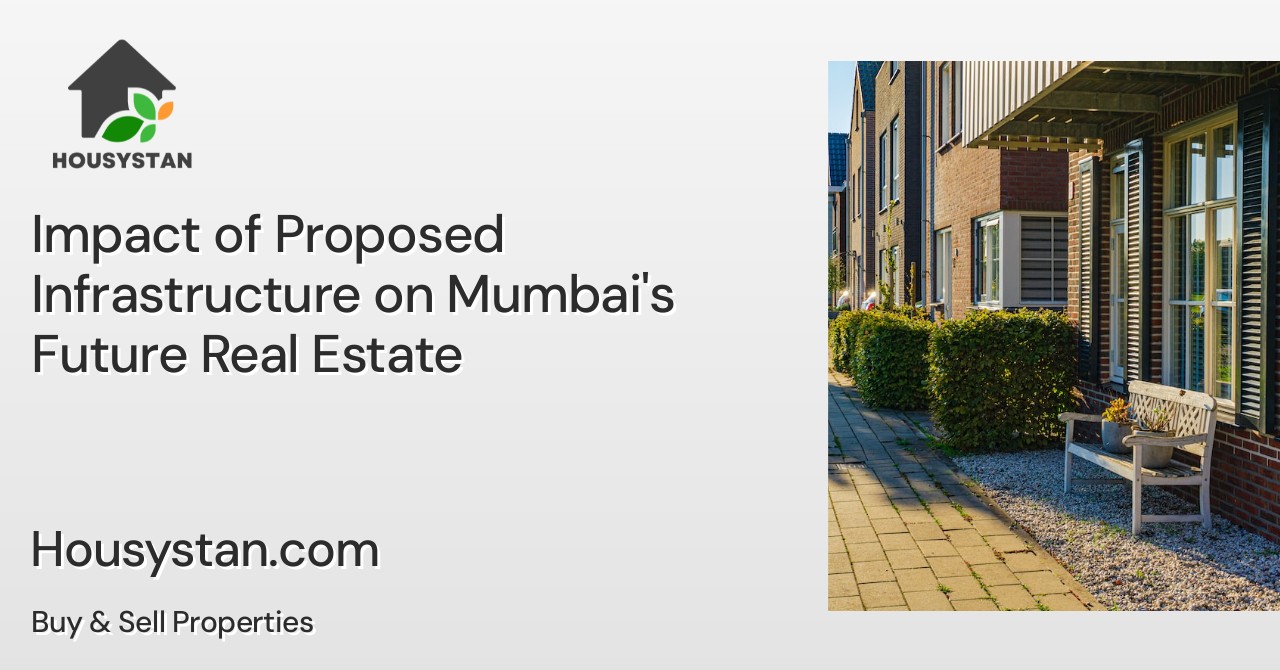Impact of Proposed Infrastructure on Mumbai's Future Real Estate
Read latest blogs and articles from Housystan

The Information mentioned here was last updated on:
11/12/2025The Impact of Proposed Infrastructure on Mumbai's Future Real Estate
Mumbai, often dubbed the 'City of Dreams', is one of the most dynamic and populous cities in India. A hub for commerce, culture, and lifestyle, it's no wonder that the city's real estate market has always been a hot topic. With new infrastructure projects on the horizon, the impact on Mumbai's real estate is worth examining. Let’s dive into the specifics of how these developments could shape the future of the property market in this bustling metropolis.
1. Overview of Mumbai’s Infrastructure Projects
- Verified Tenants/Buyers
- Unlimited Property Listing
- Zero subscription/charges fee
Mumbai is set to undergo a series of major infrastructure upgrades aimed at improving the quality of life and enhancing connectivity across the city.
- Metro Rail Expansion: Several new metro lines are underway which promise to make commuting faster and more convenient for residents.
- Coastal Road Project: Designed to relieve congestion, this project will connect key areas of the city, offering a scenic and efficient transport route.
- Mumbai Trans Harbour Link: This sea bridge will connect Mumbai to Navi Mumbai, significantly reducing travel time.
- Navi Mumbai International Airport: Once completed, this airport will alleviate pressure from Chhatrapati Shivaji Maharaj International Airport and boost surrounding real estate.
Each of these projects is targeted at reducing traffic congestion, cutting down commuting time, and bringing the city's suburbs closer to urban centers.
2. Impact on Property Prices
Infrastructure projects typically lead to escalating property prices due to improved accessibility and desirability of nearby locations.
- Accessibility and Demand: With metro expansions and roads, once-remote areas will become more accessible, sparking increased interest from potential buyers and investors.
- Increased Demand in Suburbs: Areas that were earlier considered outskirts, such as Thane and Navi Mumbai, will become attractive due to better connectivity.
- Price Appreciation: Properties near infrastructure projects, like metro stations and highway exits, may witness significant appreciation, providing lucrative returns for investors.
3. Emerging Real Estate Hotspots
As Mumbai’s infrastructure evolves, several new localities are poised to become real estate hotspots.
- Thane and Navi Mumbai: With the upcoming Trans Harbour Link and new metro lines, these areas are set to become even more desirable.
- Chembur and Kurla: With increasing connectivity and ongoing redevelopment projects, these areas are transforming rapidly.
- Western Suburbs like Goregaon: The Coastal Road Project will potentially make these suburbs more connected to the city’s southern parts.
4. Commercial Real Estate Developments
Infrastructure improvements are not only beneficial for residential real estate but also for commercial developments.
- Commercial Hubs along Metro Lines: As accessibility improves, businesses are more likely to set up operations in metro-connected areas, leading to a rise in demand for office spaces.
- Rising Demand for Retail Spaces: Enhanced connectivity translates into increased foot traffic, boosting the demand for retail spaces in emerging areas.
- Growth of Tech and IT Sectors: Areas like Thane and Vashi, with new infrastructure, might become attractive IT hubs.
5. Environmental and Social Considerations
While infrastructure developments bring numerous benefits, it’s important to consider their environmental and social implications.
- Green Spaces at Risk: Rapid development might lead to the reduction of green spaces in the city.
- Displacement and Rehabilitation: Construction of new projects often involves the displacement of communities, posing challenges in terms of rehabilitation.
- Sustainable Development Practices: With growing concerns around climate change, there’s a push for projects to incorporate eco-friendly practices.
6. Future Prospects for Investors
For real estate investors, Mumbai presents both challenges and opportunities, largely influenced by the unfolding infrastructure projects.
- Long-term Returns: Investing in developing regions can yield promising returns due to property appreciation linked to improved infrastructure.
- Risk Assessment: Investors need to consider the timelines and potential delays of infrastructure projects before making decisions.
- Diversification Opportunities: A diverse portfolio spanning residential, commercial, and under-construction projects in upcoming areas can mitigate risks and capitalize on growth.
7. Government Policies and Legal Aspects
Government regulations and policies play a crucial role in shaping the infrastructure and real estate landscape.
- RERA and Real Estate: The Real Estate (Regulation and Development) Act protects buyers and ensures transparency, boosting investor confidence.
- Policy Support for Affordable Housing: Initiatives such as the Pradhan Mantri Awas Yojana (PMAY) aim to make housing more accessible and affordable.
- Incentives for Green Projects: The government is promoting sustainable practices through various incentives, which may impact future infrastructure developments.
8. Conclusion: A Continuous Evolving Landscape
As Mumbai transforms with its new infrastructure projects, the real estate market is poised for significant shifts. These developments offer a mix of challenges and opportunities, making it a dynamic sector to watch. While infrastructure promises improved connectivity and living standards, the need for sustainable practices and community-focused planning cannot be overstated. For residents and investors alike, understanding these trends is key to navigating Mumbai’s ever-evolving real estate maze.